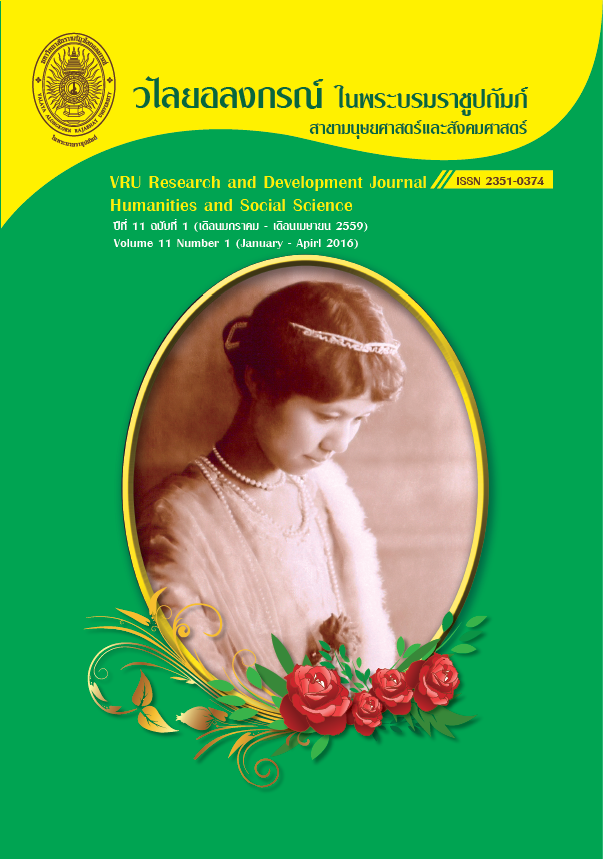การจัดการขยะแบบมีส่วนร่วมขององค์กรปกครองส่วนท้องถิ่นและชุมชน ในตำบลบ้านแลง อำเภอเมืองระยอง จังหวัดระยอง
Main Article Content
Abstract
การวิจัยครั้งนี้มีวัตถุประสงค์เพื่อ 1. ศึกษาสภาพปัจจุบันปัญหาการจัดการขยะในพื้นที่ตำบลบ้านแลง อำเภอเมืองระยอง จังหวัดระยอง 2. สร้างรูปแบบที่เหมาะสมของการจัดการขยะแบบมีส่วนร่วมขององค์กรปกครองส่วนท้องถิ่นและชุมชนในตำบลบ้านแลง อำเภอเมืองระยอง จังหวัดระยองและ 3. ประเมินรูปแบบการจัดการขยะแบบมีส่วนร่วมขององค์กรปกครองส่วนท้องถิ่นและชุมชน ในตำบลบ้านแลง อำเภอเมืองระยอง จังหวัดระยองการดำเนินการวิจัยครั้งนี้3 ขั้นตอน คือ 1. เก็บรวบรวมข้อมูลด้วยการวิจัยเชิงปริมาณโดยใช้แบบสอบถาม กลุ่มตัวอย่างได้แก่ หัวหน้าครัวเรือนจำนวน 350 คน วิเคราะห์ข้อมูลโดยใช้โปรแกรมคอมพิวเตอร์สำเร็จรูป สถิติที่ใช้สำหรับการวิเคราะห์ข้อมูล ได้แก่ ค่าความถี่ และค่าร้อยละ 2) เก็บรวบรวมข้อมูลด้วยการวิจัยปฏิบัติการแบบมีส่วนร่วม ผู้ให้ข้อมูลสำคัญ ได้แก่ ผู้มีส่วนได้ส่วนเสีย และภาคีเครือข่ายการพัฒนา ที่เป็นข้อมูลเชิงคุณภาพโดยการสัมภาษณ์เชิงลึก การประชุมเชิงปฏิบัติการและการสนทนากลุ่มหลังจากนั้นนายกองค์การบริหารส่วนตำบลบ้านแลงได้แต่งตั้งผู้รับผิดชอบหลัก จัดทำโครงการนำร่องจำนวน 6 โครงการและนำโครงการนำร่องไปทดลองใช้3) ประเมินรูปแบบการจัดการขยะแบบมีส่วนร่วมโดยการอภิปรายกลุ่มแบบเจาะจง จากผู้มีส่วนได้ส่วนเสียและสมาชิกภาคีเครือข่ายการพัฒนาในพื้นที่ วิเคราะห์ข้อมูลโดยการวิเคราะห์เชิงเนื้อหา
ผลการวิจัยมี ดังนี้ :
1. การศึกษาสภาพปัญหาการจัดการขยะในพื้นที่ตำบลบ้านแลง พบว่า จำนวนขยะมูลฝอยมีปริมาณมากเนื่องจากความหนาแน่นของประชาชนในพื้นที่ที่เพิ่มขึ้นอย่างรวดเร็ว แหล่งกำเนิดขยะที่มีปริมาณมากที่สุดมาจากครัวเรือน โรงงาน และบริษัทห้างร้าน ผลกระทบคือ กลิ่นเหม็นที่มีสาเหตุมาจากขยะดังกล่าว ดังนั้น ทุกฝ่ายที่เกี่ยวข้องจึงมีความต้องการให้มีการจัดการขยะแบบมีส่วนร่วม โดยบูรณาการระหว่างองค์การบริหารส่วนตำบลบ้านแลง ชุมชน นักวิชาการ หน่วยราชการและหน่วยงานเอกชนที่เกี่ยวข้อง
2. การสร้างรูปแบบการจัดขยะแบบส่วนร่วมองค์กรปกครองส่วนท้องถิ่นและชุมชนในตำบลบ้านแลง อำเภอเมืองระยอง จังหวัดระยอง พบว่า รูปแบบการจัดการขยะที่เหมาะสมสำหรับพื้นที่ตำบลบ้านแลง ควรประกอบด้วย องค์กรปกครองส่วนท้องถิ่น และผู้มีส่วนได้ส่วนเสีย ได้แก่ เจ้าหน้าที่องค์การบริหารส่วนตำบล นักวิชาการ เจ้าหน้าที่หน่วยงานเอกชน และหน่วยราชการที่เกี่ยวข้อง รวมทั้งประชาชนในท้องถิ่น ซึ่งเป็นต้นเหตุสำคัญของปัญหาขยะในพื้นที่รูปแบบดังกล่าวเน้นการมีส่วนร่วมของทุกฝ่าย ในการคิดสร้างสรรค์โครงการและการดำเนินกิจกรรมต่าง ๆ
3. การประเมินรูปแบบการจัดการขยะแบบการมีส่วนร่วมขององค์กรปกครองส่วนท้องถิ่นและชุมชน ในตำบลบ้านแลง อำเภอเมือง จังหวัดระยอง พบว่า รูปแบบการจัดการขยะมูลฝอยดังกล่าวมีความเหมาะสม และสามารถนำไปใช้ในการจัดการขยะในตำบลบ้านแลงได้ ทั้งนี้ทั้งนั้น “บ้านแลงโมเดล” เป็นรูปแบบที่พลวัตรหรือมีการพัฒนาอย่างต่อเนื่องให้สอดคล้องกับสภาพสังคม เศรษฐกิจ นโยบาย และกฎระเบียบขององค์การบริหารส่วนตำบลบ้านแลงและภาคีเครือข่ายการพัฒนาของท้องถิ่น
The purposes of this research were: 1. to study the problem circumstances of waste management in the area of Ban Laeng Sub - district , Muang District , Rayong Province 2. to develop a model of Participatory Waste Management of Local Administration Organization : and the communityin Ban Laeng Sub-district , Muang District , Rayong Province and 3. to evaluate the model of Participatory Waste Management of Local Administration Organization and the communityin Ban Laeng Sub-district , Muang District , Rayong Province.
There were 3 steps of doing this research which were : 1. the researcher collected quantitative data by using a questionnaire.The sample comprised of heads of 350 households. The data were analyzed by using a computer program. The statistics used for data analysis were frequency and percentage.2. the researcher proceededa Participatory Action Research (PAR) in which the key informants werestakeholders and members of waste management allies in the area obtained by a purposive sampling.The qualitative data were collected by means of in-depth interview ,and a workshop. After that , the head of Ban Laeng Local Administration appointed key personels of the working group , organized 6 pilots projects , and implemented the projects , and 3. the researcher proceeded the evaluation of the participatorywaste management project by means of a focus group which comprised of stakeholders and members of waste management allies in the area. The collected data were analyzed by means of content analysis.
The results of the study were as follows:
1.Theresults of the study on circumstances of waste management in Ban LaengSub-district revealed that there were a large amount of waste in the area because of the rapidly increasing intensity of the population.Consequently , most of the waste occurred from the households and factories including companies and shops. Their worst impact was the bad smell caused by the waste.Therefore , all related parties needed a participatory waste management program in which there was an integration between Ban Laeng Local Administration Organization , the community , academicians , related government agencies , and private sectors.
2.The results of study on the development of a participatory waste management model in Ban Laeng Sub-district , Muang District , Rayong Province,indicated that the appropriate model of waste management for Ban Laeng Sub-district should comprised of Local Administration Organization and stakeholders , especially the officials of Ban Laeng Local Administration Organization , academicians , officials of private sectors , and related government agencies , including people in the locality which were the most affective cause of the waste problems in the area. Such model stressed on the participation of all related parties in activities organizing and activities proceeding.
3. The evaluationon the model of theparticipatorywaste management of Ban LaengLocal Administration Organization and the Community in Ban Laeng Sub-district, Muang District , Rayong Province indicated that the model of participatory waste management was appropriate and applicable for the waste managementin Ban LaengSub-district. As such, “Ban laeng Model” is a dynamic model which should be in congruence with the socio – economics circumstances including policies and regulations of Ban Laeng Local Administration Organization and the waste management allies in the area.
Article Details
ลิขสิทธิ์บทความวิจัยที่ได้รับการตีพิมพ์เผยแพร่ในวารสารมนุษยศาสตร์และสังคมศาสตร์ วไลยอลงกรณ์ ในพระบรมราชูปถัมภ์ ถือเป็นกรรมสิทธิ์ของคณะมนุษยศาสตร์และสังคมศาสตร์ มหาวิทยาลัยราชภัฏวไลยอลงกรณ์ ในพระบรมราชูปถัมภ์ ห้ามนำข้อความทั้งหมดหรือบางส่วนไปพิมพ์ซ้ำ เว้นแต่จะได้รับอนุญาตจากมหาวิทยาลัยเป็นลายลักษณ์อักษร
ความรับผิดชอบ เนื้อหาต้นฉบับที่ปรากฏในวารสารมนุษยศาสตร์และสังคมศาสตร์ วไลยอลงกรณ์ ในพระบรมราชูปถัมภ์ เป็นความรับผิดชอบของผู้นิพนธ์บทความหรือผู้เขียนเอง ทั้งนี้ไม่รวมความผิดพลาดอันเกิดจากเทคนิคการพิมพ์
References
กรมควบคุมมลพิษ. (2547). การบริหารจัดการมูลฝอยชุมชนอย่างครบวงจร คู่มือสำหรับผู้บริหารองค์กรปกครองส่วนท้องถิ่น. กรุงเทพฯ: คุรุสภาลาดพร้าว.
_________.(2548).แนวทางและข้อกำหนดเบื้องต้น การลดและใช้ประโยชน์ขยะมูลฝอย.(พิมพ์ครั้งที่2).กรุงเทพมหานคร: กระทรวงทรัพยากรและสิ่งแวดล้อม.
ทศพร สืบแสง. (2553).การมีส่วนร่วมของประชาชนในการจัดการขยะมูลฝอย ศึกษาเฉพาะกรณีชุมชนส่องเหนือ เทศบาลเมือง มหาสารคาม อำเภอเมือง จังหวัดมหาสารคาม.การศึกษาค้นคว้าอิสระปริญญารัฐศาสตร์มหาบัณฑิต สาขาวิชารัฐศาสตร์ บัณฑิตวิทยาลัย, มหาวิทยาลัยราชภัฎมหาสารคาม.
พงศ์พันธ์ สุนทรชัย. (2553). การพัฒนารูปแบบการฝึกอบรมการจัดการขยะสำหรับผู้นำองค์การบริหารส่วนตำบลในจังหวัดหนองคาย. ปริญญาปรัชญาดุษฎีบัณฑิต สาขาวิชาสิ่งแวดล้อม. มหาวิทยาลัยมหาสารคาม.
ศูนย์วิศวกรรมพลังงานและสิ่งแวดล้อม. (2554). รายงานการศึกษาฉบับสมบูรณ์โครงการทบทวนผลการศึกษาวิจัยความเหมาะสมโครงการก่อสร้างศูนย์ขจัดขยะมูลฝอยรวมแบบครบวงจร จังหวัดระยอง เสนอองค์การบริหารส่วนจังหวัดระยอง. มหาวิทยาลัยธรรมศาสตร์: คณะวิศวกรรมศาสตร์.
สุกรานต์ โรจนไพรวงศ์.(2549). สถานการณ์สิ่งแวดล้อมไทย. กรุงเทพฯ: มูลนิธิโลกสีเขียว.
Eriksson, Ola. (2003). Dissertations & Theses databases.Environment and Economic Assessment of Swedish Municipal SolidWaste Management in a System Perspective. Ph.D. Thesis Sweden: Stockholm.
Fadel, M.E.I., Zeinati, M., Jisr, K., &Jamali, D. (2001). Industrial-Waste management in developing countries: The case of Lebanon. Journal of Environmental management Vol.1 .pp. 281-300.
Jurczak, M.G., Tarabula, M. & Read, A.D. (2003).Increasing participation in rational municipal
Waste management-a case study analysis in Jaslo City (poland) Resources.Conversation and Recycling Vol.38. pp. 67-88.
Kaseva, M.E., Mbuligwe, S.E., &Kassenga, G. (2002). Recycling inorganic domestic solid waste: Results from a pilot study in Dar es Salaam City, Tanzania, Resources, Conversation and Recycling Vol.35. pp. 243-257.
Kemmis, S. & Wilkinson, M. (1998).Participatory Action Research and the Study of Practice.In A. Atweigh, S. Kemmis, and P. Weeks. (eds.) Action Research in practice. New York: Routledge.
Pradhan, Upendra. (2009). Sustainable Solid Waste Management in a Mountain Ecosystem : Darjeeling, West Bengal, India. University of Manitoba (Canada).
Yamane, T. (1967).Elementary sampling theory.(6 th. Ed.). Englewood Cliffs, New York: Prentice—Hall.

